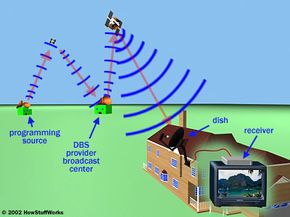Satellite TV System
Early satellite TV viewers were explorers of sorts. They used their expensive dishes to discover unique programming that wasn't necessarily intended for mass audiences. The dish and receiving equipment gave viewers the tools to pick up foreign stations, live feeds between different broadcast stations, NASA activities and a lot of other stuff transmitted using satellites.
Some satellite owners still seek out this sort of programming on their own, but today, most satellite TV customers get their programming through a direct broadcast satellite (DBS) provider, such as DirecTV or DISH Network. The provider selects programs and broadcasts them to subscribers as a set package. Basically, the provider's goal is to bring dozens or even hundreds of channels to your TV in a form that approximates the competition, cable TV.
Advertisement
Unlike earlier programming, the provider's broadcast is completely digital, which means it has much better picture and sound quality (see How Digital Television Works for details). Early satellite television was broadcast in C-band radio -- radio in the 3.7-gigahertz (GHz) to 6.4-GHz frequency range. Digital broadcast satellite transmits programming in the Ku frequency range (11.7 GHz to 14.5 GHz ).
The Components
There are five major components involved in a direct to home (DTH) or direct broadcasting (DBS) satellite system: the programming source, the broadcast center, the satellite, the satellite dish and the receiver.
- Programming sources are simply the channels that provide programming for broadcast. The provider doesn't create original programming itself; it pays other companies (HBO, for example, or ESPN) for the right to broadcast their content via satellite. In this way, the provider is kind of like a broker between you and the actual programming sources. (Cable TV companies work on the same principle.)
- The broadcast center is the central hub of the system. At the broadcast center, the TV provider receives signals from various programming sources and beams a broadcast signal to satellites in geosynchronous orbit.
- The satellites receive the signals from the broadcast station and rebroadcast them to Earth.
- The viewer's dish picks up the signal from the satellite (or multiple satellites in the same part of the sky) and passes it on to the receiver in the viewer's house.
- The receiver processes the signal and passes it on to a standard TV.
